Lotoo GT2 DAP Review - Reference Redefined
- Tokpa Korlo
- Aug 15
- 37 min read
Updated: 6 days ago
The GT2 is Lotoo's newest reference flagship creation, a super powerful summit level DAP packing the latest tech and tuned to perfection. Reference should never be boring, the GT2 is evidence of that, and then some. Forget what thought you knew, this is reference redefined.
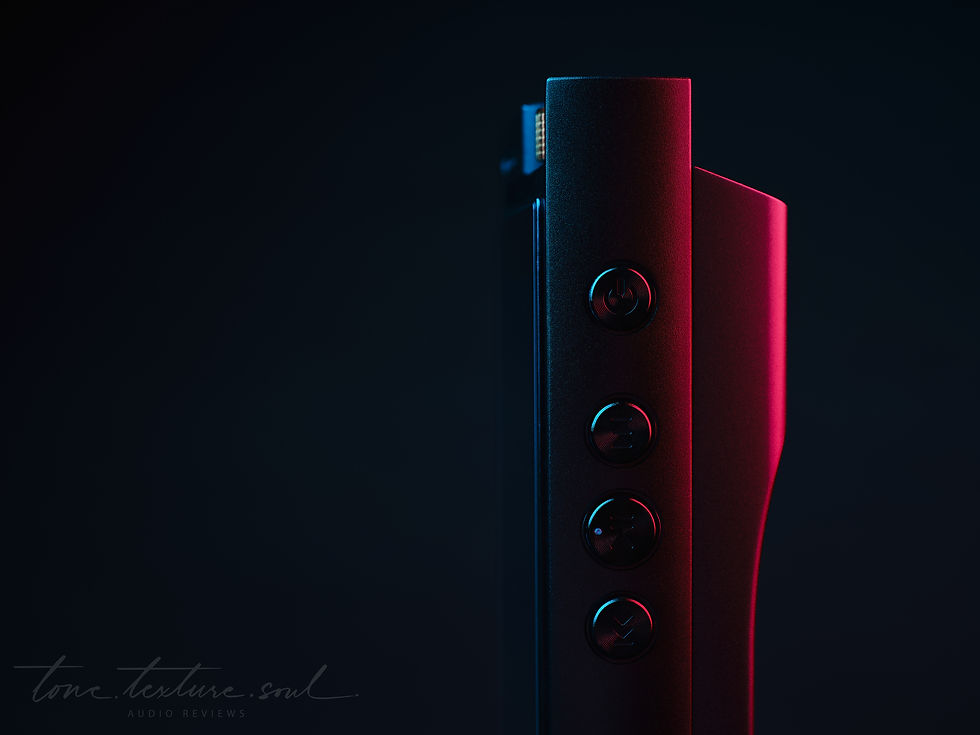
Greetings ladies and jellyspoons I welcome you to my full review of the Lotoo GT2 DAP! This is one amazing piece of gear, one that I fell in love with instantly. It manages to bring a very reference style tuning, huge power, and a very dynamic and tactile presentation that somehow is also fun and deeply enjoyable to listen to all day -and night- long. I had some limited experience with the original LPGT and while I found it very neutral and a great way to demo gear, ultimately I prefer a more muscular and dense sound with more headroom. Cue the music, enter the GT2. This is a super cool piece, in that it serves multiple purposes for me: for one it’s a great tool for testing gear, as a reviewer having a palm sized “reference” tuned DAP in pocket is fantastic. Second, it sounds freaking amazing and is such a blast to listen to I found myself listening until the battery died over and over, and over. Add in XRC (upsampling and conversion to DSD) which gives you a lot of options to further tailor the sound, and even increase resolution and dynamics. How Lotoo managed this is beyond me, but they also brought 1000mW of incredibly silent power along for the ride, creating a powerhouse of a portable music player. Thirdly, it’s a pure music player, ie no Android or anything remotely like it. No streaming either. It’s a simple, fast and smooth experience that is instantaneous and responsive, getting you right to what matters most: the music. Some might balk with no streaming, but again, cue the music - enter LTTP. I love this thing. Lotoo made their very own wireless protocol for music and it’s amazing. True lossless music, no Wifi or BT here, just a perfectly executed breakthrough I hope more companies use down the line. A small adapter goes on your source, select LTTP on the GT2 and done. No pairing, no codes, just ready to go. And the sound is spectacular.
So, it’s an amazing device, is there a catch? Well, I have some small, yet protruding qualms with the GT2. Are they a big deal? No, definitely not. Have they bothered me enough to spend hours researching, even speaking directly with the engineers at Lotoo to understand and perhaps fix or improve on them? Absolutely. Keep in mind that I did this mostly out of my need to explain in my review, not as a user. I say clearly now, if I was simply using the device as my main player I would have likely forgotten about all this a week in. Speaking to a lot of GT2 owners they ALL told me these small things didn’t bother them anymore, like at all. It is my job to cover a piece of gear in all its glory, while presenting the truth on things that can be improved on or even fixed along the way. Or stuff that’s plain bad, honesty and no fluff.
While I’ll get into them in detail later on, I quickly paraphrase here. The GT2 gets really hot, like crazy hot. While playing music, while doing nothing, it’s really hot. This is explained by the fact that the GT2 doesn’t have an idle mode for power, it’s always on and ready. That affects the battery life as well, while sitting around you’ll notice the battery die just about as fast as using it. Playing music with high gain while charging you’ll notice the battery slowly decrease, even with fast charging. Charging is also a bit funny, it’s really picky about what voltage it prefers and you’ll have to try a few to find the best match. The shelf design is, well, what it is. When you know why they did it, and how it couldn’t have been another way, it becomes more than tolerable, and I don’t much mind- far less than other critics who harp on this all day long. And that’s it! While it may sound like a lot of negatives these are all small, and the GT2 is such a fantastic device its positives and charm FAR outnumber its small idiosyncrasies 10 times over. That’s a big win as far as I’m concerned.
Let’s get into it, but first my disclaimer and testing methods.

- I received the GT2 directly from Lotoo as a long term review unit. It is mine to keep as long as I am using it, and will eventually go back to Lotoo. They also provided me with the LTTP dongle. Nothing was asked of me other than my unfiltered and honest impressions and critiques.
- I review because I love doing so, it’s a great source of joy for me. No-one pays me for reviews, ever. I take it very seriously, as I know people rely on reviews before they shell out cash for their gear, just like I do myself. For that reason I only review things that interest me, things I would maybe buy for myself. I pride myself on being very neutral and sharing my thoughts in a way that I hope will benefit the community. If I recommend something, it’s because I genuinely loved it, and I think you may too.
- To test the GT2 I used primarily my STORM, Traillii Ti, DIO, Clara and my ‘ol trusty 18t. The comparison DAPs were my modded iBasso 320MAX Ti EXN+ and LP6 Ti 7th AE. I used the GT2 Line Out into my desktop amps quite a bit as well, with my SAEQ Astraeus, Morpheus or Zahl H1.
- I start out with a very varied playlist of testing tracks to form my initial thoughts, and then spend several weeks with the review item listening to whatever inspires me, like I normally would. I then come back to the testing tracks to solidify my impressions before sitting down to write the review. I also listen to the gear while I write, one of my favorite parts.
- I love all kinds of music and to form an honest opinion for any piece of gear I think it absolutely necessary to test with lots of different kinds of music. If you’re taking a reviewer’s word about a piece of gear you want to spend your hard earned cash on, in my opinion, you absolutely should take into consideration how their musical tastes match or differ from your own.
My ever evolving testing playlist for your discovery is available HERE.
Let’s get into it shall we? Exciting!
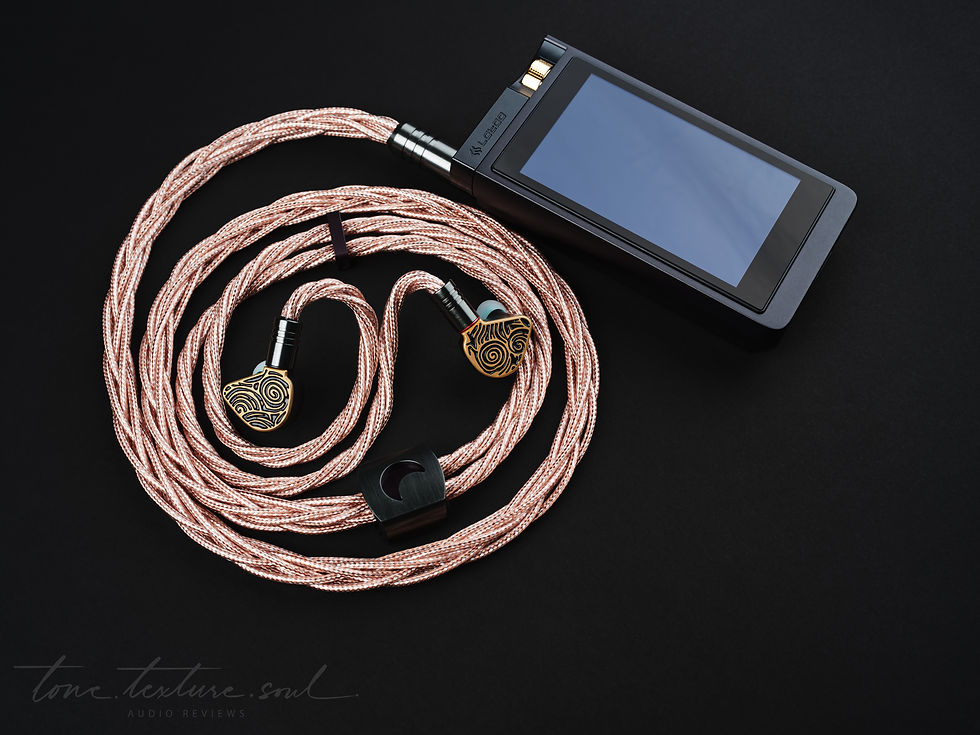

LOTOO INTRO
Lotto needs no introduction for most folks. I came to hear Lotoo first at Munich High End 2024, (late to the party) interestingly a very similar situation to my recently reviewed Zahl H1 amplifier. (REVIEW HERE) In fact, in many ways I hear and feel a lot of similarities between these two, funny enough their booths were right next to each other. While I’m not directly comparing a headphone amp to a DAP, their DNA core feels very familiar. Even using them together is boss! At the Lotoo booth I met a wonderful woman names Pauline, their rep at the show. We spent quite some time discussing gear, talking about music in general and she gave me a lot of space to check out the GT2 for literally hours on end. She was extremely kind, helpful and very joyful. Thanks Pauline for arranging all this! :)
I demoed also the Mjolnir, a very impressive piece of gear I hope to review in the future, though ultimately the GT2 fits my use case better at this point in my life, and stole my heart that day. Mjolnir, I’m coming for you next! Lotoo is well known for the LPGT, world famous in fact. It’s a fantastic little DAP, using their ultra streamlined music only UI, and is used and loved by audiophiles the world over, most of the reviewers I know use it for testing gear too. It’s extremely honest, neutral and reference in nature, something most companies don’t have the guts to do. Lack of color doesn’t mean boring at all, but it is very neutral. The Mjolnir is a mega version of the LPGT, with way more power and staging while keeping a very neutral tonality and vibe. So what is the GT2?
Based on user feedback the GT2 is the second generation LPGT, but this time it’s back with quite some changes under the hood, and a slightly repurposed tuning that will certainly appeal to more folks. It’s still quite a reference sound, especially the mids to treble are really neutral. But this time they fleshed out the lower mids and bass enough to give the GT2 more of a muscular and guttural sound, something that grabs you by the horns and powers through with extreme precision. The bass is phenomenal, some of the best I’ve ever heard in fact. It is boosted just a touch, and so those that were hoping for a completely neutral V2 of LPGT might be slightly surprised here. But I tell you, the more I listen to the GT2 the more I love it. The fat low end is toe-tapping good, and once you gets used to the extra bass I find it still leans neutral enough, especially when you compare it directly to another DAP. Coming from the LP6 AE which is very colored, or iBasso 320MAX - something I consider to be quite neutral in its own regard, the GT2 is quite a bit more neutral. Its lack of color brings it to a unique place in the highly competitive worlds of portable audio, succeeding in a very enjoyable, powerful and intoxicating sound that remains highly neutral and reference enough to test, compare, and most importantly - enjoy. I personally like what Lotoo has done here, though I would love the option of a DSP or switch type setting that brought the shelf down to neutral for the times you want to stay flat. Having both in the same box is a dream, so let’s see. I’ll get into the sound more later, let us first check out the myriad tech breakthroughs in this thing as explained by Lotoo’s website.
The PAW GT2 marks a new chapter in Lotoo’s pursuit of portable audio excellence. By merging powerful performance with sleek, compact dimensions, it sets a new benchmark for the brand's innovation in handheld music players.
Power Beyond Proportions
With its innovative, ingenious “sandwich structure”, the GT2 maximizes isolation and shielding, ensuring the purest sound experience possible. Its unprecedentedly low distortion, combined with an exceptional 133dB signal-to-noise ratio (SNR), delivers unmatched clarity to preserve the sonic precision. The output power has been boosted to an impressive 1000mW per channel. While many handheld players opt for lower power, the GT2 goes beyond, offering music with depth and precision like never before.
Achieving this balance between high SNR and robust output power was a significant engineering feat, but it’s one that Lotoo fully embraced. The result is the PAW GT2 — a palm-sized powerhouse delivering uncompromised sound quality and performance.
High Performance and Maximized DAC Chip Utilization
Lotoo’s engineering team strives to fully unlock the potential of every DAC chip, leaving nothing wasted. This dedication ensures the highest possible performance from the AK4191EQ and dual AK4499EX DAC chips in the GT2. The GT2 supports true 768kHz PCM and DSD512, setting a new standard in audio fidelity.
The AK4137EQ upsampling chip is designed for hardware-based upsampling and seamless conversion between DSD and PCM formats.
Featured Specs
Screen: 800x480 4-inch touch screen
Weight: 388g
Outputs
Headphone - 4.4 mm balanced
Max output level +20.3 dBu (S Mode)
Max output power 1000mW/ch (32Ω load) 620mW/ch (100Ω load) 210mW/ch (300Ω load) 104mW/ch (600Ω load)
Channel Isolation 122dB
Freq Response +0.006/-0.04 dB (20~20kHz)
SNR 133dB (20~20kHz, A-weight)
THD+N 0.00013% @1kHz (20~20kHz, A-weight, no load)
Headphone- 3.5 mm unbalanced
Max output level +14.2 dBu (S Mode)
Max output power 460mW/ch (32Ω load) 156mW/ch (100Ω load)
Freq Response +0.004/-0.05 dB (20~20kHz)
SNR 129dB (20~20kHz, A-weight)
THD+N 0.00020% @1kHz (20~20kHz, A-weight, no load)
Min Noise Level 0.8uV

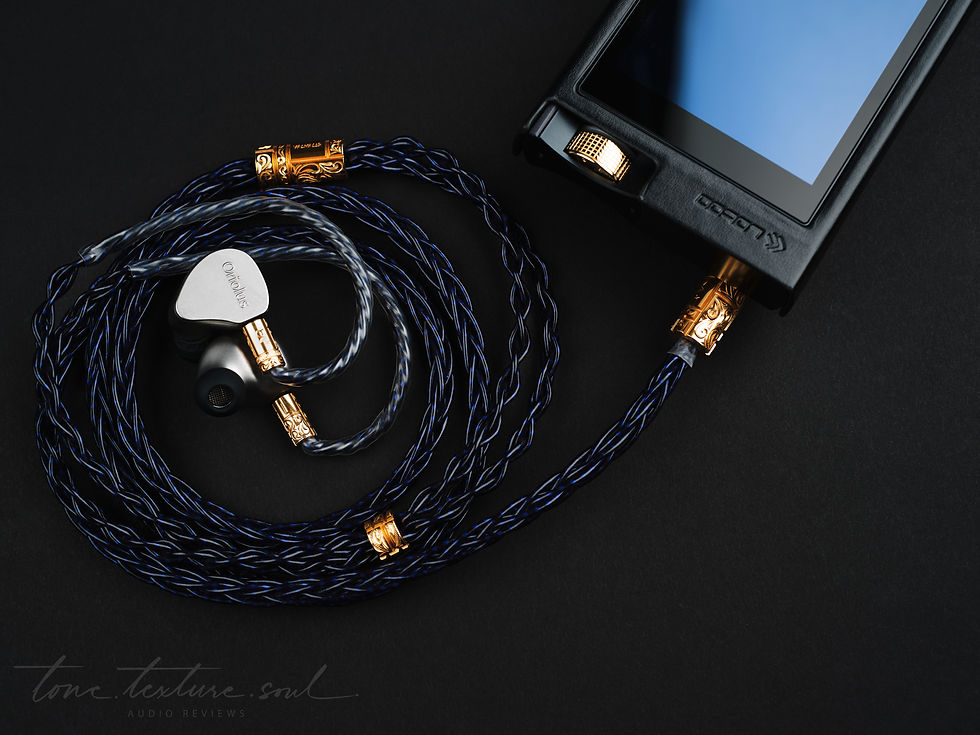

That is A LOT. Since I am not a crazy tech guy I will try and sum it up for you all, based on real use and less about paper specs.
-The GT2 uses three AKM chips (dual AK4499EX+AK4191EQ) at the same time. I don’t the typical Astell & Kern type “smooth or velvet” sound here at all, they are highly resolving and far more accurate over smooth. There is also an additional chip used for upsampling (AK4137EQ), in this case Lotoo’s XRC mode. This a great feature and has quite an impact on sound, more on that later. That means there’s three DAC chips being used all the time, and four (!) when using the XRC function.
-The structure of the GT2’s inner circuitry is extremely complicated, and they used a “sandwich” type of layout with physical shielding in between each board to achieve a nearly unprecedented 133db of SNR in balanced mode. Hence the extremely quiet and clean power even at Super High Gain. This also attributes to the GT2 amazing dynamics, with zero noise and interference you hear nothing but the music and the difference between the slightest minuscule whisper and the biggest bombastic thump are all present at the same time. Each component has it’s own power supply, thusly helping to achieve this amazing level of performance.
-It’s got a ton of power, 1000mW to be exact. In my testing that showed real world results of keeping up or surpassing the 320MAX Ti which is amazing considering how much smaller the GT2 is. I found nearly endless headroom running STORM, my benchmark for power output. While on paper the NiPO N2 shows more power, in real world use the GT2 had almost identical volume settings.
-The GT2 has a larger and much nicer screen over the LPGT. It’s bright, sharp and very enjoyable to use.
-The GT2 uses LTOS, Lotoo’s proprietary UI that is built from the ground up. It’s extremely fast, intuitive and bug free. Start up time is about 4 seconds are you’re ready to play music.
-Baked in is Lotoo’s signature PMEQ and ATE functions. I don’t use EQ of any kind, but they work very well after testing.
-The GT2 can be used as a usb DAC, and offers BT, LO and HP outputs.
-Lotoo opted to use a full size SD card supporting UHS-II. The possibility of transfer and speeds are exponentially better vs the smaller micro cards with UHS-II although it bears mentioning the cost of equal storage is much more expensive. In use I didn’t see a big difference in playback speed, but obviously loading files to the card is much faster.
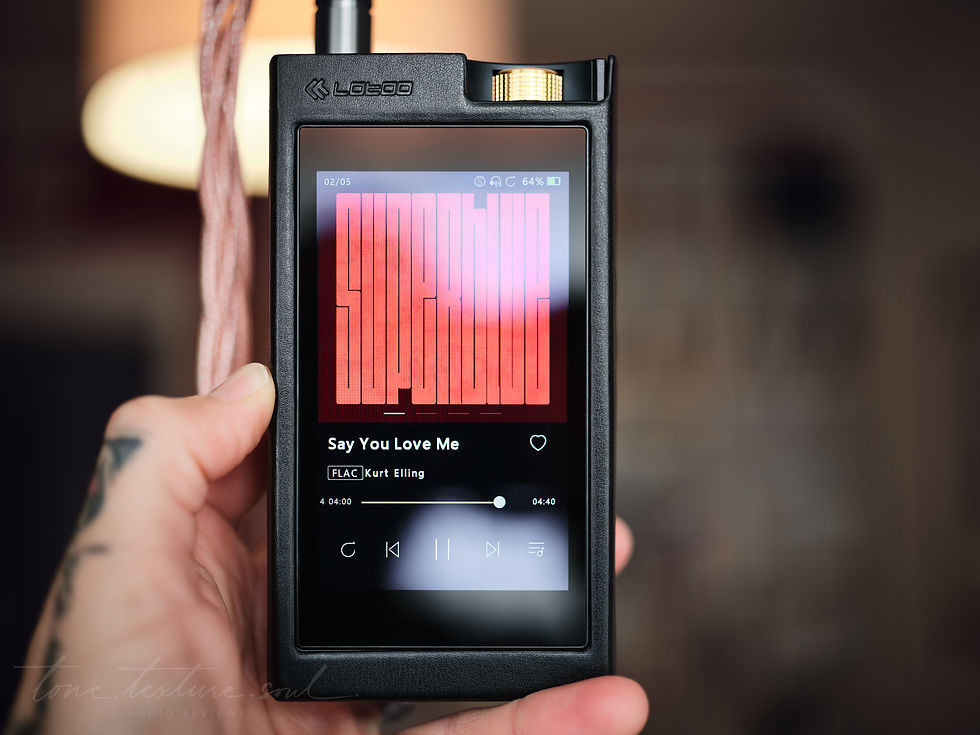

I can now address an issue I mentioned earlier - the load time. While Lotoo is famous for their almost instantaneous boot up, I found the time it takes to actually access the files and press play was far longer. About 5 seconds to boot to Home Screen which is amazing. But once there, none of the artists are available, just a screen showing “no folders” or blank artists. After about 10-15 more seconds it all shows up and the player is ready to go, but this is a far cry from the instant music claim. Is it still faster than other DAPs? Absolutely! Why do I mention it then? Because I’m being honest, and I feel this is something that can be improved. So I did a lot of research, and yes the card type does play a role in this. UHS-II cards are much faster, but investing in a 1TB UHS-II card only for the GT2 is quite the expense. If you want the fastest UI and load, this is the only way to go. With different micro SD cards you’ll see slight variances, and since I have a few Micron 1TB card, my personal favorite, I just used these. I did test also SanDisk and others, but sonically I prefer the Micron i400.
When you put in the card for the first time, or add new music, the GT2 goes into a sort of indexing mode, which makes the device crazy hot and seems to last for at least a day or so. This mystifies me completely. Once the card has been loaded don’t we expect the files to be ready? I remember the SP3000 taking a few hours the very first time and then it was ready, this is a whole new level. Adding new music should take a few moments to index, not a day or more. As someone who prefers to navigate his library via folders I would think at the very least the folders are available immediately and the metadata based information might take a bit longer. But literally nothing is there when you boot up, weird.
Yes I got used to all this, it’s not a big deal. I got used to the L&P UI, so I can get used to anything. I just want to mention it, as a new owner this may very well bum you out initially. But as is the case with most gear, after a while it becomes second nature. I turn my LP6 on and off with two hands to make sure the volume is zeroed out before plugging in. The 320MAX Ti takes about a year to turn on. Everything has its little quirks, and despite the weirdness, the rest of the GT2 UI is staggeringly smooth, quick and easy.
I did get some information directly from the software engineers at Lotoo and they are working on making this more optimized, and perhaps figuring out how to avoid some of the heat and indexing time, That’s a good sign, and I look forward to a FW update soon.



UNBOXING, BUILD, USE
The GT2 comes in a nice black box with gold design cues, inside the DAP is nestled in a bed of velvety type cloth for protection. Included are a black leather case, paper manual, two extra screen protectors (as well as the factory installed one), and a OTG usb cable. All one needs. Lotoo also nicely sent me the purple leather case which I have yet to take out of the box, I much prefer black. The leather case is quite nice with a cool metal grill design on the back for heat dissipation, and it’s rounded out with nice stitching and build quality. My only note is it’s a touch loose and usually while unplugging my cable the case slips a bit. While using the DAP I don’t feel it moving around, so you can be sure it’s safe. I would have perhaps opted to have the case extend over the top to keep it super secure but perhaps then the volume wheel wouldn’t be accessible. Moving on.
The GT2 is an impressively built device, and I can tell you the photos just don’t do this guy justice. It feels ROCK solid, with a great sense of luxury, dense weight and industrial design that works wonders for me. It’s much lighter than you’d think, and easily fits in a back pocket, The buttons are super clicky and tactile, the screen is big and bright, and it feels really great in hand. The shelf isn’t really something I think about, so there’s not much to say about it really. I did have a few issues with fitting larger diameter 4.4mm plugs in at first. I actually had to get a new 4.4mm made for my SS8 cable, such was the amazing synergy with the STORM and GT2.
Everything on the GT2 just feels great. The output ports on the top are high quality and have a very satisfying tight click when a cable is plugged in. The rather gloriously ornate volume knob, the obvious talking piece of the device that is shown quite often in my photos, is just the right amount of tight, while feeling loose enough to adjust freely. There is a USB Charing port on the bottom, as well as a plastic cover for the full size UHS-II SD card port. On the right side you have the usual buttons which feel sublime and are nice and big too. There is a white breathing light under the volume wheel if you so choose to engage it, a nice touch and seemingly less obtrusive or “bling” over some of the other rainbow style choices out there. I keep it turned off but it looks really classy if that’s your vibe.
The battery charging situation on the GT2 is a bit of a bummer, but you get used to it. As stated above, after trying many different adapters I found the fastest QD or PD outputs to be somewhat unreliable. Yes the GT2 supports them, but it charges far more correctly using a lesser voltage. After a few hours on PD I found very little charging increase, but switching from 65W to 15W and it worked a charm. Using standard 5V 1-2A was slower but worked every time. While playing music it charges extremely slowly, or even losing a percent or two an hour, so if you want to charge it all the way up I ended up turning it off to charge. Sure, this is weird behavior for a modern DAP, but like other summit gear there is always some sort of compromise for the best SQ on the planet. Coming from iBasso or L&P the GT2 is stellar and far outclasses most.
LTOS is a joy to use for me. It’s totally simple, very intuitive and lighting fast. Swipe up from any screen to get home, tap to hide controls while playing, tap again to show. Browsing is instantaneous and fun, I can’t stress how quick the UI is. It’s very simple yes, so there’s nothing to slow it down. The layout is great, even after just a few minutes I was moving freely, finding the options and menu intuitively. You can browse by folder, or metadata and they both loaded instantly with no lag or twitching. I personally prefer a pure music player, with 6TB of music ranging from vinyl rips to SACD, new FLAC and plenty of DSD files on my drive, I have more than I could ever need. I love to browse the folders like I would at my home vinyl collection, over the metadata of modern DAPs. Searching for what I’m in the mood for, choosing the album, putting it on the turntable and pressing play. Sitting back and listening with eyes closed, or working on photos. This is how I choose to experience music, and the GT2 works perfectly for me. Of course I stream as well, mostly for discovery but I do jam out quite regularly at my studio via Roon or Qobuz. If I want to use the GT2 all I need is to grab the LTTP dongle and voila.

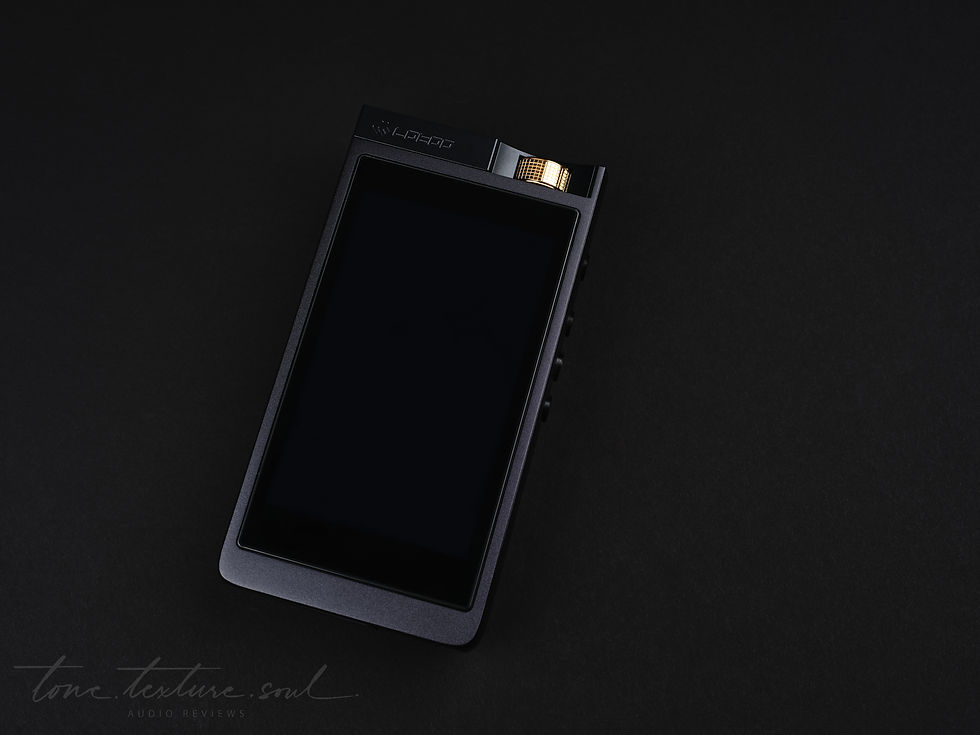


LTTP
Aptly named Lotoo Teleportation Protocol, LTTP is “Lotoo’s proprietary wireless technology developed for transmitting lossless, high-resolution audio, which unlike Bluetooth or Wi-Fi is designed only for audio. With a maximum transmission rate of 1.5 Mbps and support for up to 96 kHz / 24 bits”. This is true lossless, streaming right from your source device be it phone, tablet, laptop etc into the GT2 where you get all the glorious sonics only a DAP such as it can provide without wires. In use the LTTP is flawless, sounds amazing and requires no setup. Plug in the dongle, select LTTP from the Home Screen of the GT2 (second page swipe to right) and it connects automatically. That’s it. You get a screen that shows the fader level, a selectable High Quality mode (lossless) and the connected device. Realistically you would keep the device screen turned off and just browse the music via your source, but it’s nice to have this basic info, plus the faders look cool if you choose to have it on every once in a while. I am also sure the lack of Wi-fi and streaming greatly affects the utter silence and world class SNR the GT2 has, and since I personally prefer local files this decision is just fine for me.
For someone coming from USB DAC from my DAPs to stream, LTTP is a joy and honestly sounds virtually the same. Testing local files and streaming the same file from phone I could hear almost no difference. Besides the lack of wires and seemingly impossible micro loss in SQ, the only negligible factor I might assume is my Micron SD card which has an extra bit of resolving power over standard cards I’ve tried. I certainly won’t open that can of worms at the moment, but suffice to say LTTP sounds fantastic and makes the GT2 a full and complete package for those who need streaming functions some of the time. Obviously if you love Android and stream only, the GT2 may not be the best choice for you in the case of convenience. And if you need streaming from source and absolute peak SQ then you may bat an eye here. But sonically, and with the addition of LTTP, the GT2 may just win you over anyway. It has for me, and I’m a staunch old school local file guy. I can use Roon ARC from my iPhone, get 24/96 lossless audio directly into the GT2, and skip Apple’s ridiculous lack of hi-res codecs. Or sit on the couch and run Roon on my laptop to the GT2. Or all my downloaded content on Qobuz for long flights. So cool!
The dongle itself is small, comes with USB C and Lightning plugs, and easily fits in your pocket or bag. It’s small enough to get lost in your bag or purse too! In use it holds well, the connection is super solid and it’s rather unobtrusive. If you plan to use your phone all day like normal the dongle does impose somewhat, especially for the way I hold my phone while typing I have to reconfigure my fingers at the bottom a bit. But that’s no different to any BT dongle or the like. I have the Fiio BTR17 in order to get LDAC from iPhone to my GoPods and this isn’t any worse, even being a bit bigger. The BTR17, or any BT dongle Ive tried always struggle with connecting, taking a bit of back and forth every time to get going, even cutting out while my phone is in my pocket. Not so with the LTTP, it’s been a breeze.
TL:DR Lotoo’s LTTP is a sonic revelation. It sounds incredible, is stupid easy to use, and for ~$100 it’s an absolute no-brainer.



SOUND
After all that tech stuff how does it sound? It sounds incredible. The GT2 is one of my all time favorite DAPs to date. Having heard a billion of them, with only the tremendous LP6 Ti 7th AE and modded iBasso DXN320 MAX Ti (NPAudio EXN+) still with me, the GT2 holds its own in my stable. I love its unbelievably textured and guttural bass, and those super resolving mids and highs that have zero color and give me a perfectly neutral platform to which I can tailor IEM and cable to my liking. It has a big muscular sound, with thick notes and dense weight that I love so much. I would call it ‘reference with a slight L’ in tuning, but don’t be deceived by the bass shelf. It’s not bassy, it’s more thick down under. It gives you this meaty low end that extends into the mid bass and lower mids, then peels off as we get into the mids. But it doesn’t sound lean or thinner up top, that’s some Lotoo magic. The bass is simply slightly boosted, mostly in the sub bass region, so the transition to lower mids and mids is very clean and without bleed in 99% of cases. I did on occasion hear a bit too much midbass using my Clara and Nocturne with the GT2, but only on a pretty bassy track to begin with. Most instances with this combo have glorious bass.
Before we of further, let me quickly explain my personal understanding of the difference between REFERENCE, TRANSPARENT and NEUTRAL.
Reference means it’s presenting music as it was mixed and mastered. That does not mean it’s boring or flat, it simply means it’s a REFERENCE to the original recording. If it was mixed bombastic then bombastic it shall remain, soft then soft it will be. You have the Harmon curve, the RIAA curve for vinyl etc, so if a piece of gear is truly reference it will adhere to the “correct” reference source and sound as it should.
Transparent means THAT piece of gear allows the signal to pass through unaffected, more like a piece of glass where you can see straight through. Transparent doesn’t mean reference or neutral, it is less about tuning and more about the quality of the components and design that allows such transparency or glass like quality. My recently reviewed Zahl H1 amp is the pinnacle of transparency. From my understanding you can’t really call a DAP transparent, I would instead use this term more for cables, DACs and amps. I would not call an IEM transparent either. Reference or neutral yes. Typically transparent is far more expensive, creating something that truly gets out of the way is far more challenging than adhering to a reference curve. This is just how I experience it, so keep that in mind.
Neutral could be confused with reference, but they are different. Neutral means the tuning adds no color, no peaks or dips, and could be called flat in which it’s adding nothing. True neutral is not always what people want, especially in the Head-fi realm where out of head presentations and endless extension rules the day. If you love a bit of extra sparkle, some sub bass lift, or thicker lower mids all that is not neutral. Neural means just that, nada added. I tend to think about it like lack of color or weight, where reference can still be thick or thin, bright or dark, neutral is more flat. Neutral doesn’t necessarily have to be super expensive, this is more a tuning choice. The LGTP is very neutral, as is the Mjolnir. The NiPO N2 is very transparent also. Reference is harder to achieve, but still doable. The STORM is famously a very reference tuned IEM. True transparency is reserved for the best of the best, and only when built to do so. I realize I may have just lost many of you, so if you can’t follow my mind’s OCD understanding of the difference between neutral and reference, or plain don’t agree with me, or don’t care, that’s all good and please feel free to swap them ‘round as you wish. Just so you know where I am coming from.
Here is the fun part: when we build our chain we can MIX and MATCH these attributes to our liking. Have a super warm IEM and want to clean it up? Add on a very neutral cable. Use a super transparent and neutral amp. Your source is a touch too cold and sterile? Put a tube amp there, or a copper cable that adds some weight and fullness. Feeling mellow and warmish? Switch on XRC conversion to DSD and it all smoothes out, feels more rich and velvety, and warmer to boot. Everything being neutral and reference isn’t always good either, it depends on your tastes. For testing I love my Weiss204 with Zahl H1 amp, they are both extremely neutral and transparent, even to a fault. But I could mix and master on tat setup, as many have done in the past. Same goes for GT2 as source with LO. It’s not the warmest or most relaxing for an all night listening sesh, but holy cow is it resolving and scary good. If I want something a bit less intense or colored, I could use my LP6 Ti as source, or swap the amp for my SAEQ Astraeus for an equally godly presentation that is more colored but also more fun. I would think that more people would prefer the lush and godly combo over the sinfully accurate and transparent one. But this is why we have choices! I could also change out the RCAs for something fuller, something I was playing with just last night. I could also use my SAEQ Morpheus for a similarly mid forward and punchy sound, albeit a touch less resolving and more sinful. The combinations are endless, and the only limitation here is your patience, and your wallet of course. As is the case in audio all the time, how it makes you feel is the only thing that matters. I tend to use very transparent reference gear and then color with a cable or IEM to my liking. This way you’re perfecting your base line and then just add topping as you wish. (My favorites as a kid were gummy bears, I’ve now graduated to old man granola!)
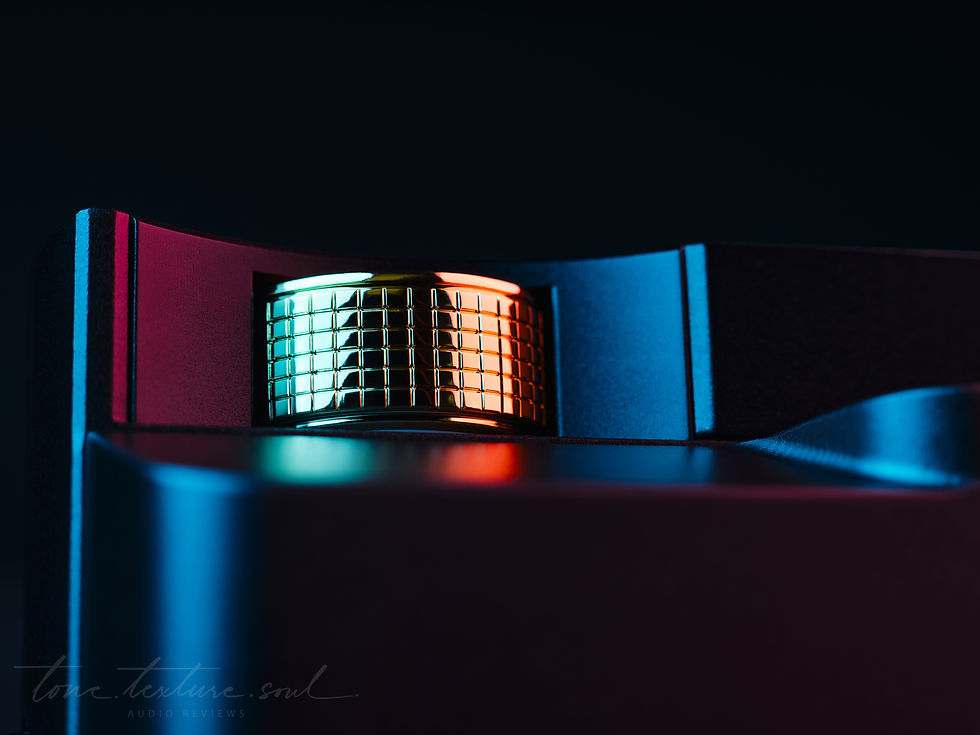
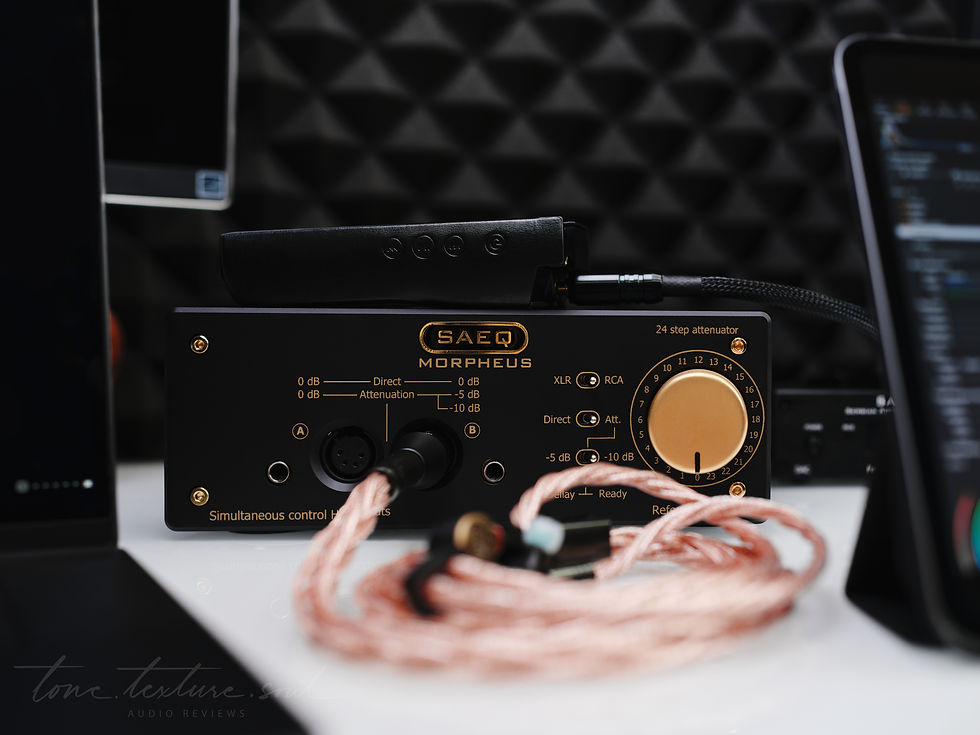
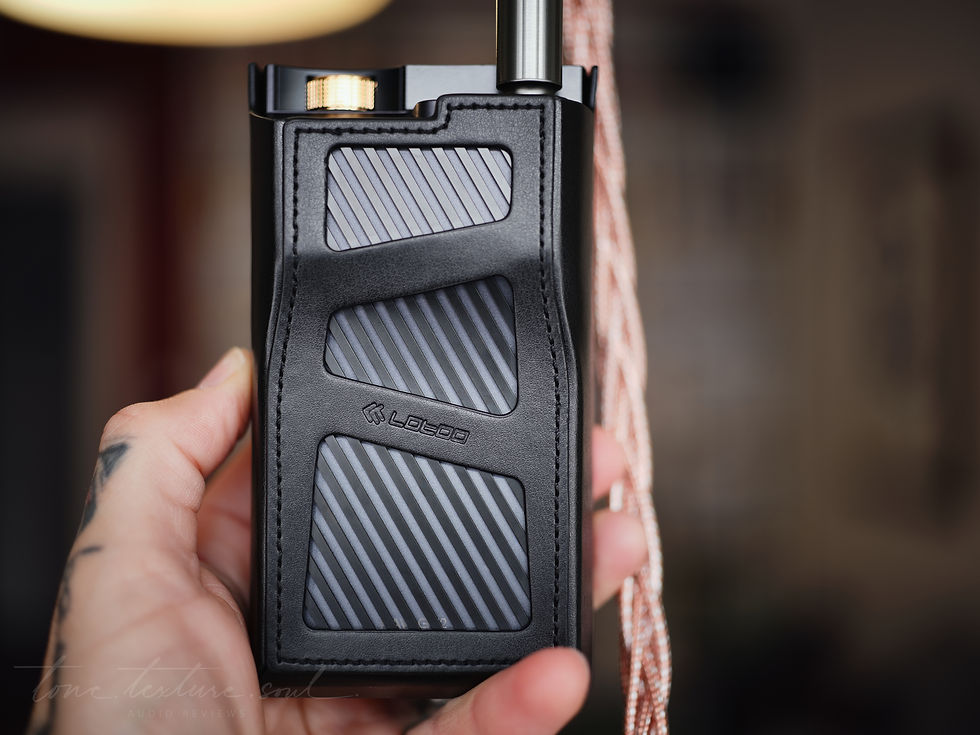
Is the GT2 reference? Mostly. If I am checking out some new gear, testing new IEMs or wanting to see what a cable does the GT2 is a perfect choice. I can hear how the original recording was mixed, and if something sounds off or altered, I know where to start looking. And it won’t be the GT2. In that way I enjoy the GT2 as a reference DAP quiet bit. For just hanging out I love it as well, and it’s a great honest presentation of my music. There is a slight bass shelf, so complete reference cannot be used so concretely. If you learn where the shelf is, and how it affects your gear, the GT2 can absolutely be used AS A REFERENCE for testing gear. It’s still quite neutral, and the lack of color is very much appreciated for my tastes. If you desire pure neutral reference sound the LGTP has it in spades, but it lacks the power, headroom, and chunky muscular tone where the magic of the GT2 resides.
What the GT2 adds, is a dose of fun and thickness. It makes the notes bigger, meatier, more impactful and solid. It has a more statuesque foundation, everything is planted and very tactile - but it stays uncolored. The bottom has more quantity and presence, but it’s not colored. No warmth or extra anything, just more. Here we could use that word again, Neutral. So we have a mostly reference DAP, with a slight L shape down low that adds some fun and thrust but remains Neutral. Does that make sense? I hope so! (You might now finally appreciate my clarifying paragraphs above, or not)
XRC
XRC is Lotoo’s upsampling tech, and it’s super cool. It adds in an extra DAC chip (AK4137EQ) and either upsamples your incoming PCM to 96KHz, 192KHz or 384KHz - or if you so wish - converts your PCM to DSD then upsamples to either 5.6Mhz or 11.2MHz. This is no gimmick, the effect is kind of amazing, but it will certainly come down to personal preferences if you like it on, or off. At the very least it’s a cool tuning tool that gives you some options. It’s awesome that you can choose the sample rate and not just a flat ‘upscale’ as I hear quite a big difference between the settings and my enjoyment with it varies between settings a lot. In DSD the higher up you go the more the effect is noticeable, pushing the presentation forward, adding some more weight and smoothing things out of bit, but there is an increase in perceived brightness and loss of lushness that comes along with the increase in sample rate. Using PCM the effect is less noticeable but all settings are far more similar and it just seems to get better the higher you go.
Using PCM upscale I like it at the maximum (384KHZ), the change in tonality is very similar to default off, but there is a sense of more detail and power. It feel more immediate and punchy, with a greater sense of air and space. Super cool! I don’t hear smoothing here, just a jump in dynamics and clarity that I think a lot of people will love.

Upscaling to DSD I found myself enjoying the 5.6KHz option, using 11.2KHZ seemed to lean out the sound too much, and while it felt like there was “more detail” the magic of that “DSD” sound seems to wane and be more digital. This isn’t a surprise as with my R2R gear there is also more clarity but some of that analog magic is lost to the higher clarity. Using DSD you get a warmer and more forward sound, with smoother transients and more lush mids. Treble is smoother too, but I don’t hear any roll-off which is good. You get more bass, but it’s mostly in the mid bass thump area, with a loss of sub bass extension that is quite noticeable especially when AB’ing. The whole presentation is more laid back, and some of the immediacy we have in default is lost. It’s sort of like going backwards from the NOS on R2R gear. Staying NOS keeps all the magic, using the filters add some punch, or clarity with the loss of that analog magic. XRC tends to reverse this, and it gives the GT2 a really cool additional tuning option.
Whether you choose to use XRC will come down to your tastes, even down to each album and your current mood. I had it off most of the time, some testing with it on, and then back to stock. At this moment I’m listening to some Dire Straits rips and XRC on with DSD sounds wonderful. An hour ago I was playing some Robert Glasper Black Radio stuff and I much preferred stock or PCM 384KHz. Staying PCM keeps the Lotoo reference tonality, while engaging DSD obviously changes it up a lot, sounding smoother and more vintage. This is a great contrast to something like DAR from A&K. DAR adds a lot of dynamics and power, something I feel is missing in the default form of the SP4K. I always had it on. The GT2 is already super dynamic and powerful, so the XRC is more about tastes, and whether you prefer neutral or warmish vintage. Staying PCM it’s kind of a no-brainer to upscale to 384, using the DSD option is less obvious, but supremely cool with the right stuff.
TL:DR - If you want maximum race car drive, switch on XRC to 384KHz PCM conversion, if you like more of a vintage muscle car vibe, switch to DSD at 5.8KHz. For classical music you may enjoy DSD 11.2KHZ for utter clarity and smoothness. Or, if you want it RAW, keep XRC off and just enjoy the Lotoo ride.
I’m going to leave it on for the next few days and see, perhaps I’ll end up leaving it on all the time too!
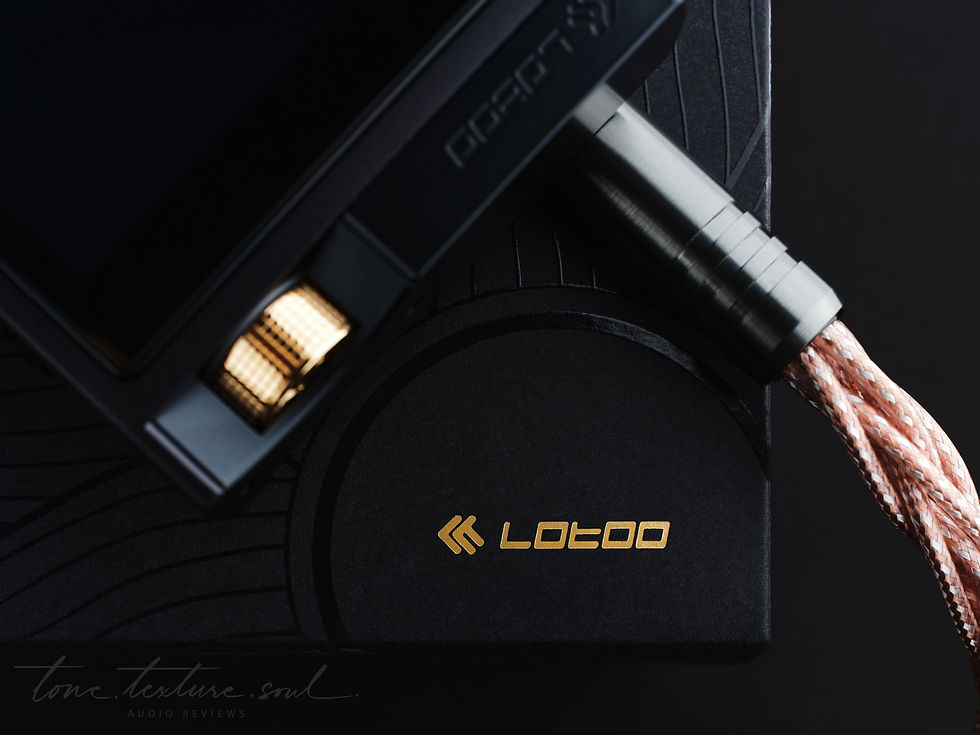
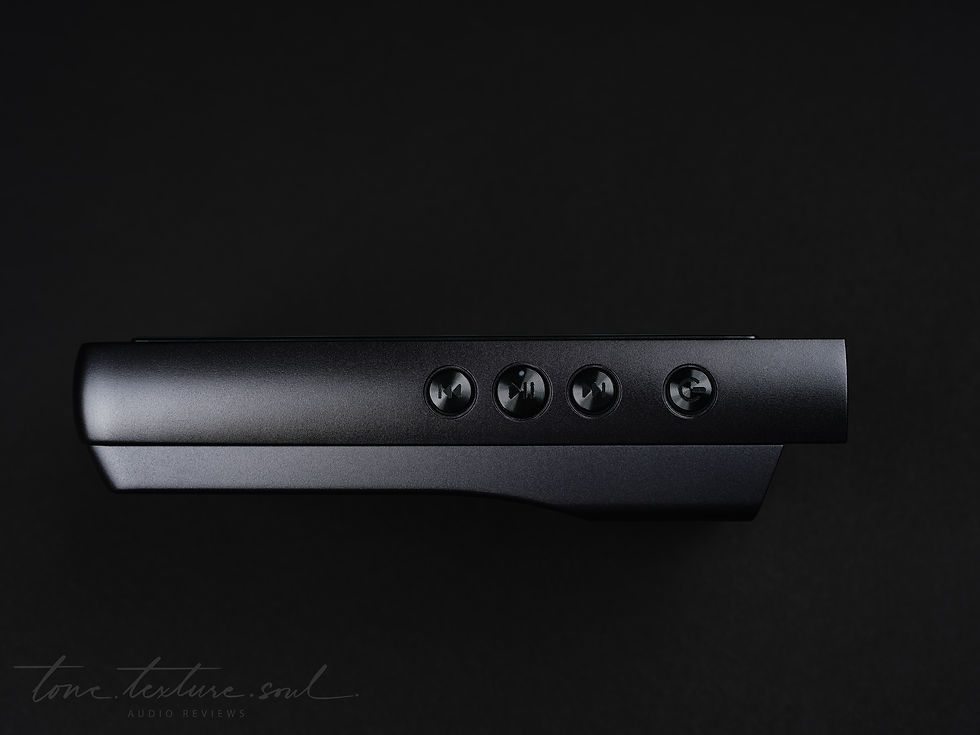
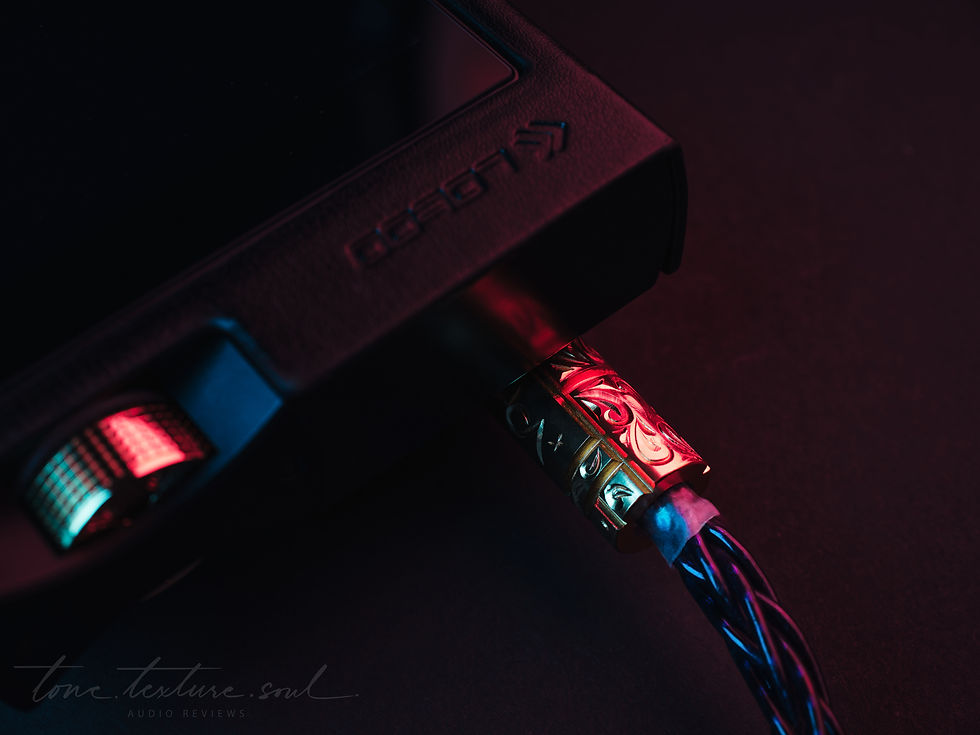
BASS
The GT2 has phenomenal bass that is some of the most textured, rumbly and bone shacking I’ve ever heard. Super punchy, deep and throbbing, or light a s feather a supremely textured. What strikes me every time is just how controlled it is, so taught and precise without losing out on fun and slam. It’s equally adept with sub bass pounding Cryptic Minds or Om Unit as it is with punchy mid bass ala Snarky Puppy or Avishai Cohen. In keeping with its reference nature I hear clear differences between types of basses, even on the same album, the timbre and tonality is fantastically accurate. This isn’t some imposing bass that lathers everything in bloom and thud, or is always blasting or gut tumbling, the bass tone changes dramatically according to the recording. The bass isn’t NEUTRAL but it is reference in terms of tonality and timbre. Modern bass sounds modern, think Dave Matthews Band’s Stefan Lassard, Victor Wooten ’s Fodera or Jimmy Johnson’s active Alembic trademark tone. A 50’s P-Bass thuds and thumps with those flat wound strings ala Pino Palladino or Jaco’s Mid bassy ultra punchy fretless percussive attacks. Synth and 808 inspired sub bass dives are wholly impressive and accurate. Think Massive Attack, Om Unit, Kryptic Minds or even hip hop like Dr Dre and Tribe Called Quest. Decay and bloom are also deeply tied to the original track. They all sound just like the record! That’s reference, it’s just a bit more for fun too.
MIDS
The upper 2/3 of the GT2 are more reference tuned and very neutral. While the bass has some extra quantity the same cannot be said for mids and treble. That doesn’t mean they sound cold or sterile, not in the least. They are also not thinned out, or feeling like a pyramid tuning. The GT2 mids are wonderfully full bodied, very detailed and resolving with a great sense of air between the instruments. Here is where we start to get the sense of the GT2’s staging prowess, providing very impressive separation and space off to the sides and in the depth and decay departments. I hear great micro details, nice articulate transients that never edge into sharpness or shrill, instead staying very defined but lacking fatigue enduring edges. Instruments sound faithful, accurate and deeply emotive too. While you wont find ultra lush and gooey tube like mids here, you will be amazingly surprised at just how musical the GT2 is. I can’t stress this enough, reference doesn’t mean flat or cold, the mids on GT2 are some of the best representations of accurate and correct mids Ive heard from a portable device. Add in the extra weight and density and you have a palpable, physical and powerful presentation that is as unique as it is enjoyable.
Vocals sound huge and full, we don’t hear any weird tonal or timbral changes between male or female vocals, no chestiness or honk. They sound lovely, clear as a bell, and with plenty of reverb and cascading lip smacks echoing off to the sides for days. Guitars sound ripping and guttural, or sweet and sinewy, screaming solos or articulated plucky nylon strings. Hitting that sweet spot for me, mids that sound so correct but still have a good dose of body and magic is really hard to nail with such finesse. Lotoo have hit this part out of the park.
Whether it’s Kandace Springs, David Byrne, Mark Knopfler, Cassandra Wilson, Lizz Wright, Jose James, Finnegan Tui or Rag’N’Bone Man they all sound so real and natural. Just as the trumpet of Roy Hargrove or Miles Davis flow freely, Coltrane’s barking horn next to his modern alter ego Nubya Garcia’s slightly smoother yet raw tone, it all sound so accurate and “correct” to my ears I can just bask into melody not stuck wondering why Asgeir’s voice has this weird peak or Pavarotti has a muddy hump in the lower mids. No painful horn blasts or overly compressed snare hits here.
As the GT2 mids are very clean and clear, they are amazingly resolving too. If you have a poor recording it’s not going to sugarcoat it for you, those old metal recordings will be as intolerable as ever. But treat yourself to some good quality recordings and the GT2 will amaze you, both with its pristine SQ and tactility, but also in the gorgeous way it does so. Using XRC affects not only the tonality of the mids, but the way they are presented too. More forward, and with more body and smoother transients. If you like sultry emotive vocals try the DSD option, it is really amazing.
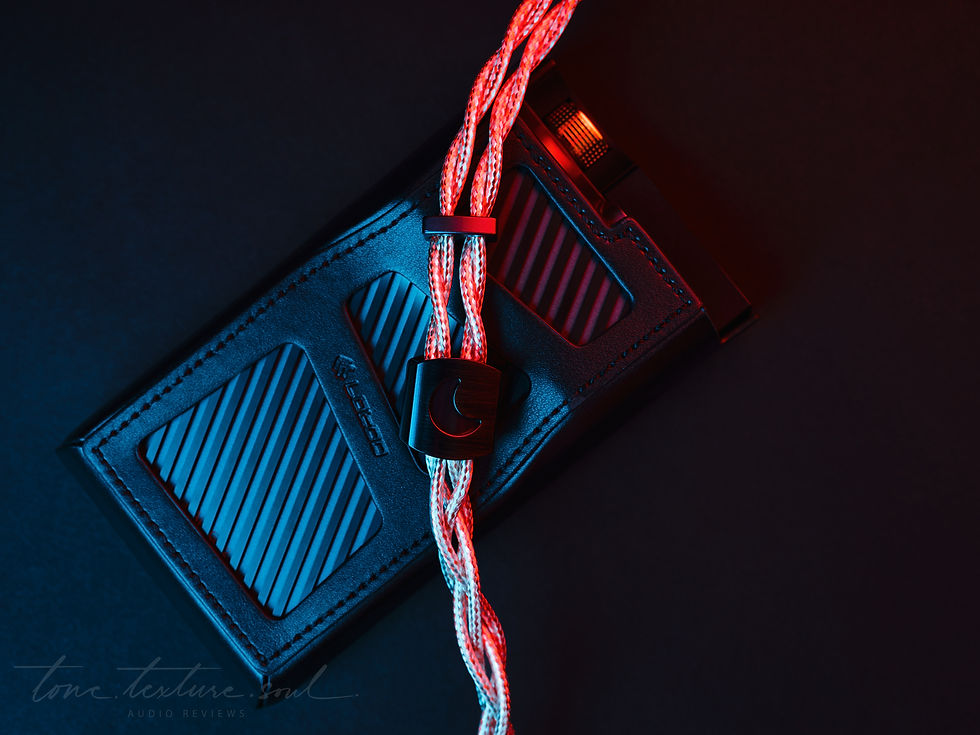

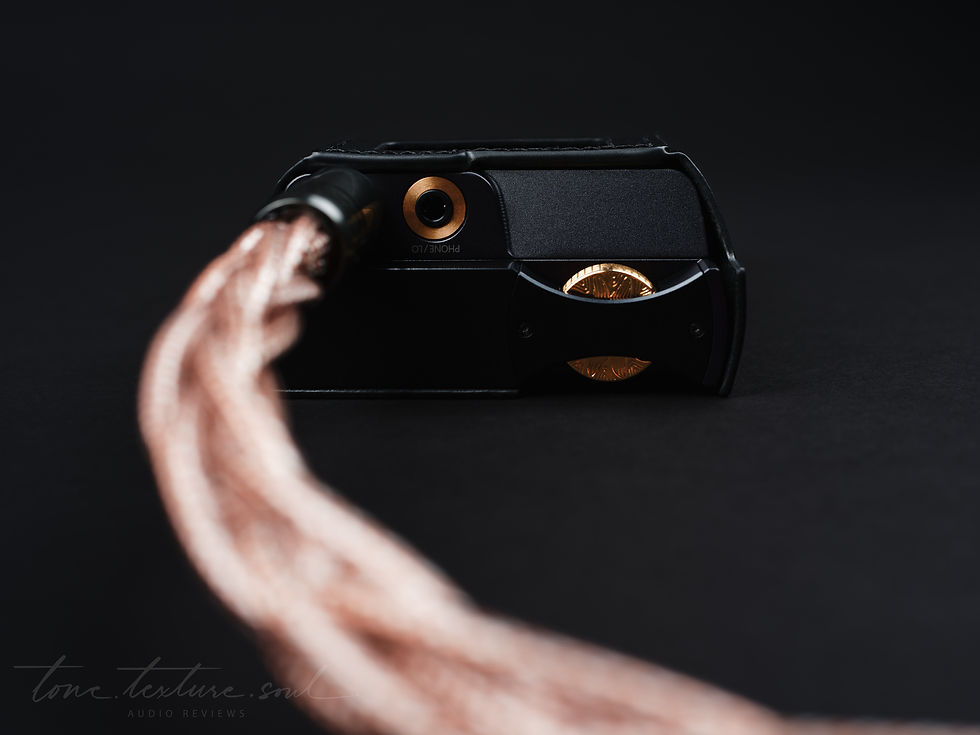
TREBLE
The treble here is wonderfully done, I like it a lot. It is very resolving and quite neutral so don’t expect endless or extra anything. Clean, clear, articulate never harsh or overly smoothed out either. Neutrality is often felt most in the treble region as we are more accustomed to some adjustments made here to add spice, space, brilliance or smoothness. I covered this in my review of the Zahl H1, and here again I find striking similarities. I would say in the mids and treble the H1 and GT2 share most of the same traits, they are fast and articulate, neutral in their presentation and yes, as reference as one could want. They have no color but are not fatiguing at all. There is sparkle as needed, but no more or less than the mix intended. With a very reference IEM or HP it can border on too much information if you’re not used to it, so feel free to color it to your tastes along the chain. I for one find this kind of presentation as mesmerizing as it is impressive. I have been listening to the new Jordan Rakei “Live From the Royal Albert Hall” album on loop all morning with that exact combo and it’s phenom legend stuff. The bass is ridiculous. I love how I get this super meaty bass and yet the backup singers panned far left are still so clear and gentle.
XRC affects the treble by smoothing it out in DSD mode, or creating more space and air in the higher sampling options staying in PCM. For more modern music I tend to add DSD as it can help smooth out the overly mastered and processed mixes, while older music I prefer stock, or PCM upsampling to add a bit more intensity or clarity.
DYNAMICS
I have quite a few torture tests for dynamic range. Something like Deftones’ Digital Bath give me a good idea of how much range I have, and in that, the clarity and abilities the chain has in terms of layers of vastly different sounds played simultaneously. It has extremely loud parts, and soft and sweet parts, all mixed together in a 90’s metal sludge that makes me smile as only a boyhood fav could do. In poor systems treble can be harsh, and the bottom half is mud city. This is especially heard in the hi-hat attack, guitar nasal sibilance and shrieking vocals through a megaphone. In the best system this is a wall of sound that provides an almost unbelievable amount of energy, but it isn’t be bright or harsh. You should be able to pinpoint all aspects with clarity and definition. You should be able to hear how crystal clear and analog full the drums were recorded, while allowing the guitars to be all at once scooped/Dual Rectifier’ed and Marshall JMP’d as Stephen Carpenter was doing at the time. The bass is fuzzy but clear somehow, with a distinct thud and growl. There is quite some production quality underneath too, a first for the Def guys. If you can hear all that, your system is killer. If it sounds like a constant wall of sound then your DR is suffering some. If something gets lost, or you can’t differentiate between different sounds, your chain is lacking. But don’t fret, only the best systems can produce such amazing results, in real use there is always some kind of compromise, especially in the portable realm.
Asgeir and Bon Iver are great for this too, their mixture of low-fi, sweet and sultry, poorly recorded slinky plinky guitars mixed with big bass and electronic drums are a masterwork of demanding energy for your system. If you can clearly hear the different timbal qualities and even recording qualities living besides each other in the same track, this is a good sign. Not overly cleaned up, or warmed to death, a true torture test.
Headroom plays a big role in dynamics, in that the loudest part of your tracks needs to be held in place with great power and control. The more power you have, technically the more headroom you have, and even the deepest bass plunge or snare attack will be met with unrelenting control and clarity. The GT2 has tons of power, and this translates into a great deal of headroom and control. Especially in the bass, no matter what is going on I never hear a squelch or complaint, it just keeps on going. A vast array of tonal soundscapes with thundering drums which abruptly halt into a single whisper and breath, all presented in faithful and clear precision, only a few DAPs I’ve ever heard have this level of dynamics. In fact only one surpasses it, the LP6 Ti 7th AE, whose thunderous nature can be a bit too much for some people. Not Me :) That’s the level we’re at here. The softest parts should have control too, not taking you need to crank it up to hear the subtleties and space.
No matter what you throw at the GT2, from Paris folk songs and soundtracks to grungy death metal, opera, classical, rock and the fastest funk imaginable all sound so controlled and amazingly dynamic. Like a race car at the starting line, you can literally feel its coming rocket like acceleration. The GT2 lets you know it has plenty in reserves, and then gets out of the way and lets you enjoy the music.
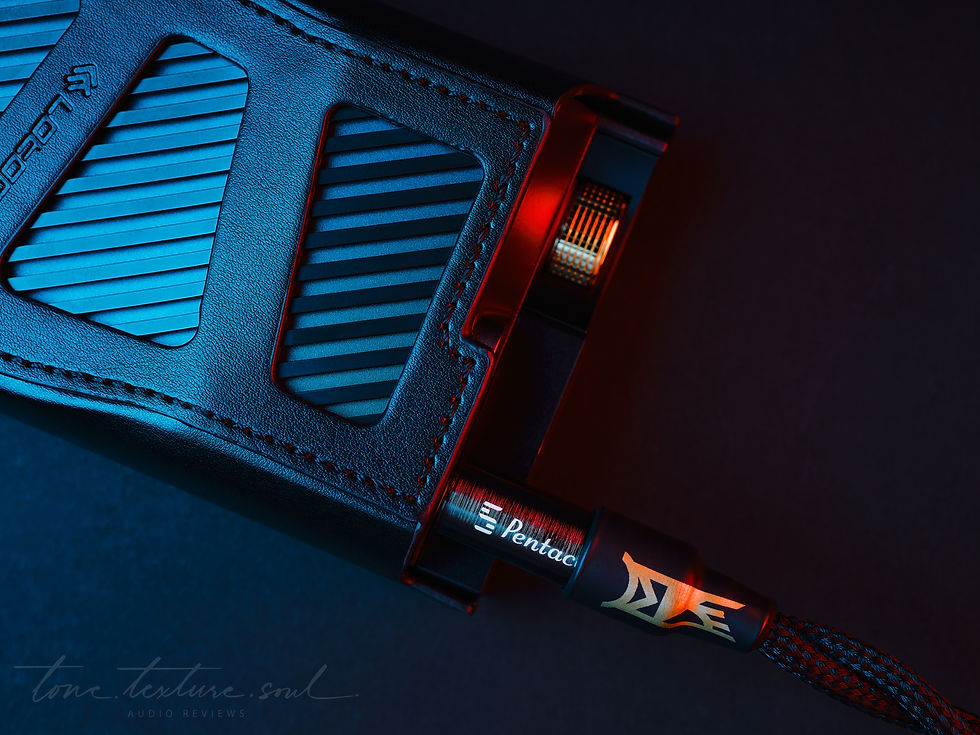

COMPARISONS
Comparing DAPs is a lot of fun, and I spend hours, (I mean more like days) going back and forth to spot, relish and eventually cope and come to terms with their differences. See that I said differences, and not better or worse. There is a large amount of grey area here that feeds on all of our personal tastes, mood, ear hydration and lack of sleep. I have compared the GT2 to my two everlasting favorites, but they’re all different enough that one doesn’t make the others obsolete, or really lacking at all.
iBasso DX320 MAX Ti
Initially when I first heard the MAX I was dissapointed. It has a slightly metallic and bright lower treble peak that took far too much of my attention. I did get used to it, and came to love it more and more. I eventually decided to get the EXN+ mod from NPAudio and I have never been more satisfied with a DAP’s changes. It is now much larger sounding, more analog and rich, far less bright and all the ears and digital glare is gone. While I know it’s not really fair to compare a modded DAP to something fresh out of the box, but since all in they have a similar price I want to compare this way.
In terms of usability the GT2 smashes the iBasso to a bloody death. The UI is vastly simpler, fast and easy. The MAX takes a few minutes to load, the screen is small and there’s a lot of lag. But MAX is Android with full streaming, so that’s a big win for most. MAX is way bigger, being more transportable over the GT2’s small and light build. Going past all that, they have some sonic differences.
The GT2 is undoubtedly the more neutral of the two. But it has a bit more bass, interns of texture as well as actual quantity. Quality too, GT2 bass is stellar. With the mod the MAX is more open, with a further away 10th row kind of presentation. GT2 is more intimate, which also makes it feel more immediate and forward. The MAX has more air, and the stage is more desktop level, where the GT2 is massive but feels more all around you in stead of way out in front. I like both the stages, it’s really up to tastes, or mood. MAX feels more analog and lush, a bit warmer, where the GT2 is more neural in terms of tuning but also flavor and color. I hear stronger transients on the GT2, the MAX is more floating and endless. Overall the MAX feels more linear in terms of all aspects being the same size, volume, and girth - the GT2 does come off more bass heavy with L leaning. But this is purely from comparison, when I come from the LP6 Ti AE the GT2 sounds positively neutral.
It should be mentioned that with XRC DSD on the GT2 gets more like the MAX, in that there’s more of a smooth and analog vibe going on, and less neutral ref. With XRC PCM 384KHz on I get more of a stock non modded MAX type of sound.

Luxury & Precision LP6 Ti AE
This one holds a dear place in my heart, and will never be replaced. It has outlived everything in my collection, and I see no reason why it would ever leave. The combination of extreme dynamics, super resolution and insane R2R texture makes the LP6 impossible to beat. But that doesn’t mean I don’t use the GT2, or MAX either. The LP6 UI is atrocious, simple isn’t even the right word. More like bare bones and in progress with the final version coming with indefinite delay. I have come to love the UI, just chose the album and go. Looking for any kind of wireless connection? NOPE. It plays music and does nothing else, and the battery life is less than 4hrs for me. But, and this is all that matters, the sounds is insane. A thunderous presentation that is as at home with classical as it is death metal, vocal to literally die for and bass that will knock your socks to next week.
It is however very colored, crazy thick and dense, and with a ton of midbass. The GT2 holds it own here where I get a somewhat similar thick and dense sound with zero of the color. Technicals are on the same level, thought the LP6 is again more grand while the GT2 is more intimate. LP6 has a treble roll off and a sub bass cutoff, the GT2 has neither. Sub bass on GT2 is better, and those that like top end and upper treble brilliance the LP6 could leave you wanting. Some IEMs don’t work with the LP6, like the HEX or warmer IEMs with midbass punch. It just gets too bassy, to thick, especially with my great love the Orpheus cable - too much of a good thing. (Remember how I was talking about mixing and matching components and the value of neutrality and transparency?) The GT2 gives me a nice muscular sound that works with everything, wonderful synergy with all my gear. While the LP6 is undoubtedly more analog due to it 4x R2R chips, the GT2 is a safer choice for those wanting an all-rounder that works with anything. The LP6 is also a bit of a unicorn, impossible to find and costing at least 2x as much as the GT2. There is no LTTP, only USB DAC in. GT2 can do USB DAC in and out.
Interestingly, while the LP6 seems more powerful with some IEMs, like blow your ears off, it will not power STORM. I get cutouts and meager performance, where the GT2 powers the STORM like a madman, reaching deafening volume at 50% power on super high gain. While the LP6 is more dynamic, the GT2 isn’t far off, with seemingly more headroom to boot. While the LP6 Ti AE is my favorite DAP ever, the GT2 is easier to use, has more flexibility and far less color while remaining thick and dense. To compare these two directly should clue you in to how much I like, and am impressed by the GT2. Boom.
XRC doesn’t get you anywhere near the LP6’s level of analog and richness. It’s a nice option to slightly warm and smooth the GT2, but it is undeniably a DS DAP and should be treated as such.

Zahl H1 Amp (REVIEW HERE)
I won’t compare an amp to a DAP, but I do find a lot of similarities in how they make me feel. I’ve also spent the past month listening to the GT2 non stop, half the time in LO through my Zahl H1. An astounding combo to say the least. The H1 is insanely transparent, the most transparent piece of gear I’ve ever heard in fact, and it allows the tonality and qualities of the GT2 to shine unabated. The similarities are thus:
-The GT2 bass is more present with quantity, they both have deeply punchy and guttural bass that is extremely taught and controlled. The tonality is very similar too, staying tighter and less decay than others, and allowing the recording’s timbre and authenticity to shine through in the bass.
-Mid are very similar, both quite neutral and very resolving, with a razor’s edge of difference between too crisp and sharp or too relaxed. I hear no timbral weirdness between male and female vocals, I hear no tuning tricks or funny business for clarity or staging’s sake. It’s a magic spot to be in, and the GT2 nails that perfectly, which is especially impressive for a dap.
-Treble is also very similar, super resolving and neutral without sounding cold, dry, stunted or smoothed. Neither of them cause any discomfort or shrillness, fatigue or boredom, while remaining as resolving as I’ve heard in such a form factor.
-Funny enough staging feels similar too. The Zahl isn’t the biggest stager out there, but it keeps a perfectly harmonious stage that can feel super vast but always realistic. Add in the stage control and you can adjust the space, air and depth another few notches which really opens it up. The GT2 has the same kind of vibe, never pushing things too far out but remaining one of the larger stages I’ve heard in a DAP.
While the H1 is transparency defined, the GT2 is reference redefined. Using the H1 with GT2 has the exact same tonality and magic, just bigger, better and even more headroom. Everything has more control, space and dimensionality. Kick is harder, vocals have more weight and presence, but the tuning is the same. Of course for maximum SQ using a desktop rig is going to yield better results, but a DAP is great so you can move around. I don’t feel like I’m missing out on anything using only the GT2, it feels raw and open in the palm of my hand. But I know when I get home I can pop in the H1 and the whole thing keeps that same magical quality, just more so.

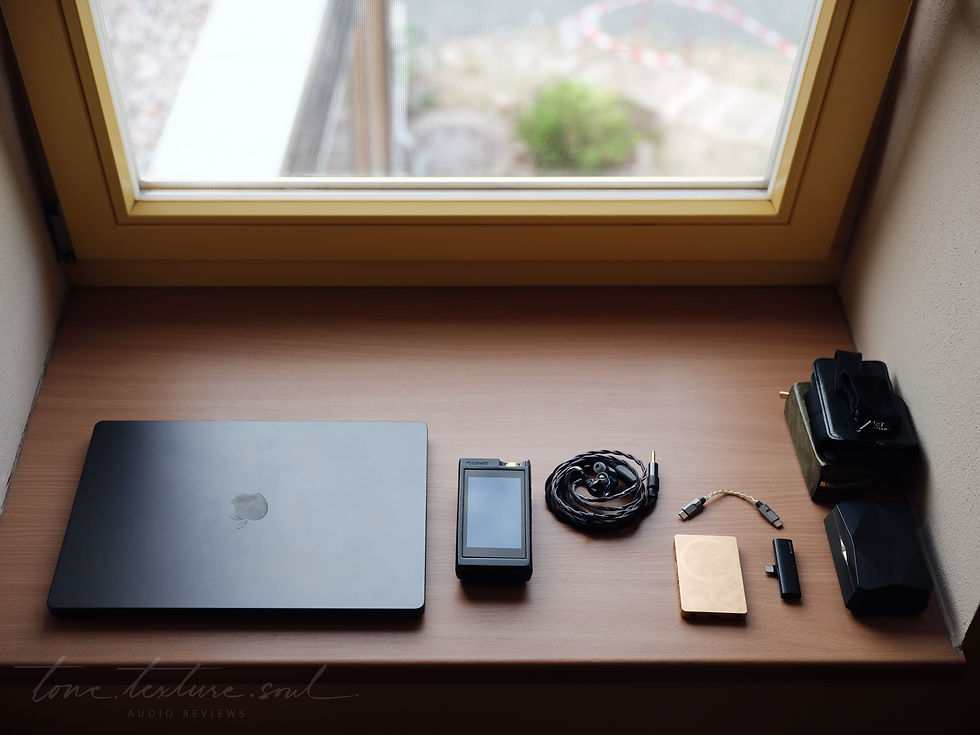

CONCLUSION
That was a lot of info. I hope it was enjoyable to read! I haven’t done a review of such in depth tech before, more often relying on sonics alone, but with the GT2 what they put inside to make it sound this good, is as interesting and inspiring as the sonics alone. It’s a fantastic music machine - it’s also a feat of hardware and software engineering. The UI is spectacular, smooth as silk. The sound is deep and meaty, while remaining neutral enough to feel a confidence in its reference abilities. XRC is amazing and gives us a lot of options for personalizing the way it plays our tunes. LTTP is nothing short of a use-case revelation for me. And all that power, ohhh, let’s not forget that part. I love the GT2, I’ve made that quite clear by now, and as such it earns my highest recommendation.
Is it perfect? Definitely not, but the several design irregularities and quirks are more than made up with the sound and UI. Choose, play, enjoy. As a reviewer, and an insanely spirited tester, the GT2 has earned its spot as my new reference. I know it has a small bass shelf, but I can accept and adjust for that while testing, and forget about it completely when just listening. This is reference for the masses, reference for fun and the love of music. It’s anything but boring, this is Reference Redefined.
I wish to thank Pauline of Lotoo for organizing my demo unit, you are so kind and a pleasure to deal with. Now I just have to get the Mjolnir over here for the next review! If anyone wants to get one of these GT2s for themselves I always recommend MusicTeck to do so. Andrew is a gentleman and always does everything and anything he can to help get you the gear you crave. I’m in no way affiliated with MT, just hooking you all up. You can use the MT link here, You can also browse Lotoo’s dealers to find one in your area here.
Stay listening my friends, stay true to music. All that matters is you enjoy yourself, let the music be your guide.
Thanks for reading!

Comments